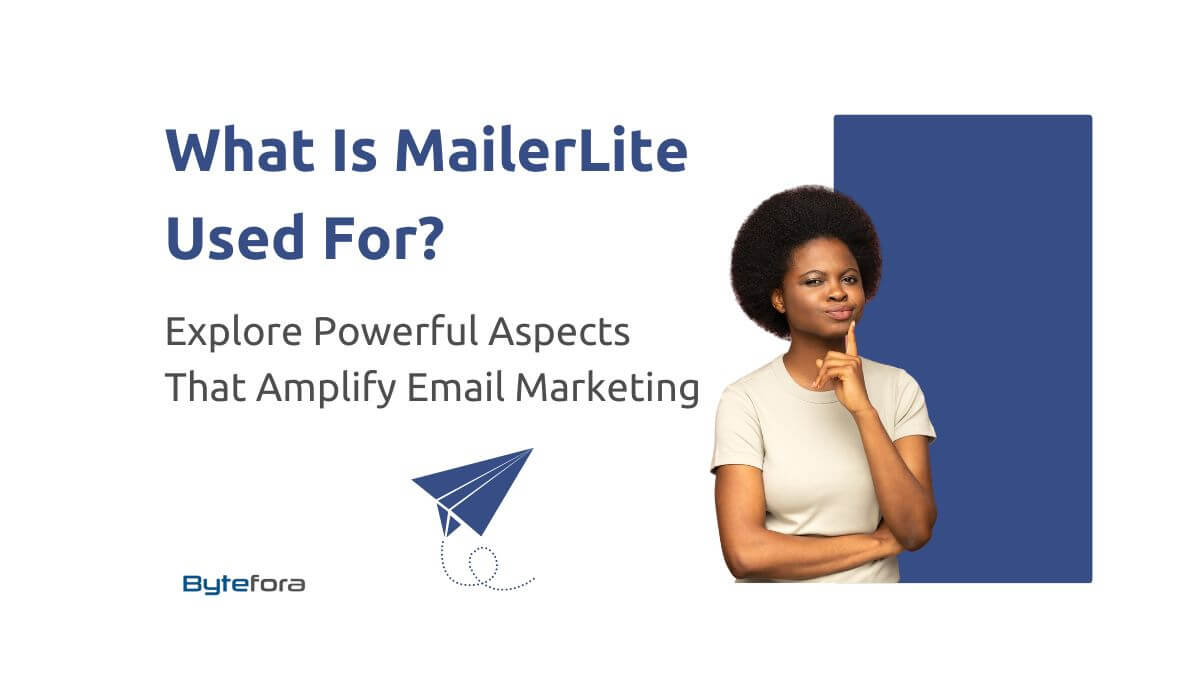Introduction to Email Marketing Platforms
Email marketing remains a cornerstone of digital marketing strategies, integral for businesses aiming to establish a significant online presence. The landscape of email marketing is rife with tools that help marketers manage their campaigns more efficiently, boost conversions, and enhance customer engagement. Among these tools, MailerLite and Mailchimp stand out as two of the most prominent platforms, each offering distinct features tailored to meet the diverse needs of businesses.
MailerLite and Mailchimp serve a critical purpose in the digital marketing arsenal by streamlining the process of reaching a wide audience through targeted email campaigns. These platforms assist businesses in not only creating visually appealing emails but also in tracking the performance of these campaigns. Tracking metrics such as open rates, click-through rates, and conversion rates are crucial for optimizing ongoing and future email marketing efforts.
Service providers like MailerLite and Mailchimp are designed to support both established corporations and small enterprises, enabling them to craft personalized messages that resonate with their audience. By leveraging these email marketing tools, companies can foster stronger relationships with their customers, promote brand loyalty, and ultimately drive sales. Whether it’s a small business looking to maintain a consistent communication flow with its customer base or a large organization managing extensive mailing lists, the utility of these platforms in achieving marketing objectives is undeniable.
In today’s competitive digital landscape, the ability to connect with potential and existing customers through well-crafted email campaigns can significantly influence a company’s success. With robust features such as automation, segmentation, and A/B testing offered by both MailerLite and Mailchimp, marketers are better equipped to deliver messages that are not only timely but also relevant. The effectiveness of email marketing is underscored by these platforms’ ability to help businesses refine their strategies and achieve higher engagement rates.
As we delve deeper into the specifics of MailerLite and Mailchimp, we will explore how these platforms compare in various aspects, thereby providing a comprehensive guide to help you determine which tool best suits your business’s unique needs.
Pricing and Plans
When it comes to choosing the right email marketing platform, understanding the pricing structures and available plans is crucial. Both MailerLite and Mailchimp offer tiered pricing that can cater to various business sizes and needs.
MailerLite’s pricing tiers start with a free plan that allows up to 1,000 subscribers and includes essential features such as email automation, templates, and basic reporting. The paid plans begin with the Basic tier, which offers additional features like advanced reporting, unlimited emails, and premium customer support, starting at $10 per month for up to 1,000 subscribers. The Premium tier, which starts at $50 per month, provides further enhancements such as dedicated IP, advanced reporting, and priority support.
On the other hand, Mailchimp also provides a free plan, but it is slightly more restrictive, allowing up to 500 subscribers and including basic email templates and single-step automation. Mailchimp’s paid plans include Essentials, Standard, and Premium. The Essentials plan starts at $11 per month for 500 subscribers, offering additional features such as multi-step automation and custom branding. The Standard plan, priced at $17 per month for 500 subscribers, introduces advanced audience insights, send time optimization, and behavioral targeting. The Premium plan, beginning at $299 per month, is designed for large enterprises, offering advanced reporting, multivariate testing, and phone support.
It’s crucial to consider the value for money each platform offers. While MailerLite’s pricing is generally more affordable, Mailchimp offers a broader range of advanced features, particularly in its higher tiers. However, it’s essential to be aware of additional costs. For example, Mailchimp may charge extra for add-ons like transactional emails (Mandrill) and dedicated IP addresses, whereas MailerLite tends to bundle these features within its existing plans.
Ultimately, your choice between MailerLite and Mailchimp should depend on your specific needs, the complexity of your campaigns, and your budget. While MailerLite offers a cost-effective solution with robust features, Mailchimp provides more advanced tools that may justify its higher price point for certain businesses.
User Interface and Ease of Use
In the realm of email marketing platforms, user interface and ease of use play pivotal roles in determining the overall user experience. MailerLite and Mailchimp, both renowned for their capabilities, offer distinct approaches to user interface design and accessibility.
MailerLite prides itself on its minimalistic design, emphasizing simplicity and functionality. The dashboard is clean, clutter-free, and highly intuitive, making it particularly appealing for new users. Key actions are logically organized, and the drag-and-drop editor is user-friendly, allowing for easy creation and customization of email campaigns. MailerLite also provides a broad range of templates that can be swiftly adapted to fit various marketing needs, further simplifying the setup process. Most users find the learning curve for MailerLite to be relatively low, offering a smooth onboarding experience.
On the other hand, Mailchimp offers a more robust and feature-rich platform, which can appear overwhelming to beginners. The interface is visually appealing and well-organized, but the abundance of features can take time to master. Mailchimp’s drag-and-drop builder is similarly powerful and versatile, but the multitude of options might require a more extensive learning process. However, experienced users might appreciate the depth and control available through Mailchimp’s advanced customization features and comprehensive template library. Accessibility is enhanced through insightful tooltips and a structured help center designed to guide users through various tasks.
A prominent difference between MailerLite and Mailchimp is the focus on user experience. MailerLite targets users who value simplicity and ease of use, making it a suitable option for those looking for straightforward email marketing solutions. Conversely, Mailchimp offers a steeper learning curve but benefits users who require a more expansive toolkit and are willing to invest time in mastering its functionalities.
In conclusion, both MailerLite and Mailchimp cater to different user needs in terms of interface and ease of use. While MailerLite’s simplicity and user-friendly design benefit newcomers, Mailchimp’s comprehensive features and customization options appeal to more advanced users. Selecting between the two will largely depend on individual preferences and specific marketing requirements.
Email Design and Templates
The effectiveness of email campaigns significantly hinges on the design and template options provided by the marketing platform. Both MailerLite and Mailchimp offer robust solutions in this regard, albeit with differences in variety, quality, and customization capabilities.
MailerLite excels in simplicity and ease of use. It offers a diverse assortment of email templates, enabling users to select designs that suit various themes and purposes. MailerLite’s drag-and-drop editor simplifies the creation process, allowing users to craft professional-looking emails without requiring extensive design skills. Furthermore, the platform permits users to create templates from scratch, providing a blank canvas for more advanced customizations. The editor supports a significant degree of flexibility, ensuring that users can modify every element within the template to meet brand-specific requirements.
On the other hand, Mailchimp is renowned for its extensive collection of high-quality templates. Offering a broader selection than MailerLite, Mailchimp’s template gallery caters to a wide array of industries and marketing objectives. Similar to MailerLite, Mailchimp provides a user-friendly drag-and-drop editor that facilitates seamless email design. However, Mailchimp goes a step further by integrating advanced design features, such as dynamic content blocks and pre-built layouts, that enhance the customization process. Additionally, Mailchimp’s templates are inherently mobile-responsive, ensuring optimal display across devices.
Both platforms allow users to import their custom HTML templates, which is particularly advantageous for businesses with specific design requirements. The flexibility of template modifications on each platform ensures that users can align their email campaigns closely with their branding guidelines. While MailerLite offers a straightforward approach conducive to beginners, Mailchimp’s extensive features are more suitable for users seeking advanced design capabilities.
In essence, the choice between MailerLite and Mailchimp for email design and templates largely depends on the user’s proficiency and the complexity of the design requirements. MailerLite offers a balance of simplicity and functionality, whereas Mailchimp stands out with its comprehensive and intricate design options.
Automation Features
When comparing the automation features of MailerLite and Mailchimp, both platforms offer robust solutions designed to optimize email marketing efforts. Automation plays a crucial role in managing tasks such as auto-responders, drip campaigns, user segmentation, and behavior-triggered actions, ensuring that businesses can maintain communication with their audience effectively and efficiently.
MailerLite provides a straightforward interface for setting up automations, making it accessible even to those with limited technical experience. The platform offers standard features like auto-responders and drip campaigns, which allow users to send a series of pre-scheduled emails based on specific triggers, such as a subscriber joining a list or completing a survey. User segmentation in MailerLite is highly customizable, enabling marketers to create targeted segments based on various criteria, including engagement levels and demographic information.
In contrast, Mailchimp offers more advanced automation capabilities, appealing to both novice and experienced marketers. It supports the creation of complex workflows through its visual automation builder, which includes more intricate triggers and branching logic. Mailchimp’s advanced segmentation features allow for dynamic audience segmentation based on real-time data, enhancing personalization efforts. Additionally, Mailchimp excels in providing pre-built automation recipes, which can be particularly useful for users seeking quick, effective solutions without needing to design a workflow from scratch.
Both platforms provide comprehensive support to assist users in setting up and optimizing their automated workflows. MailerLite offers extensive resources, including tutorials, webinars, and a responsive customer support team. Similarly, Mailchimp provides detailed guides, a knowledge base, and access to email and chat support to help users navigate and implement their automation strategies.
While Mailchimp’s automation features may offer more complexity and flexibility, MailerLite’s user-friendly design ensures that even beginners can leverage automation to enhance their email marketing efforts. Ultimately, the choice between MailerLite and Mailchimp will depend on the specific needs and technical proficiency of the user.
Analytics and Reporting
Analyzing the effectiveness of email campaigns is crucial for refining marketing strategies. Both MailerLite and Mailchimp provide comprehensive analytics and reporting tools that enable users to delve into key metrics such as open rates, click-through rates, delivery rates, and conversion tracking.
MailerLite offers a user-friendly dashboard that prominently features essential metrics for any campaign. Users can quickly access data on open rates, which reflect the percentage of recipients who opened the email, and click-through rates, indicating how many clicked on the email’s links. Delivery rates, capturing the percentage of successfully delivered emails, and conversion tracking, which maps out customer actions following email interactions, are also readily available. MailerLite’s integration of visualizations, such as pie charts and bar graphs, makes it effortless for marketers to interpret data trends and adjust their strategies accordingly.
Mailchimp, on the other hand, also excels in providing robust analytics and reporting functionalities. Upon accessing Mailchimp’s dashboard, users are greeted with a detailed overview of vital metrics, including open rates, click-through rates, delivery rates, and conversion tracking. Mailchimp differentiates itself through its advanced reporting capabilities, presenting data in a more granular manner. Leveraging visually engaging elements like comparative line graphs and detailed heatmaps, this platform allows marketers to break down the data by various segments, such as demographic patterns and engagement behavior.
Both platforms emphasize the importance of data visualization to aid decision-making. While MailerLite focuses on simplicity and ease of use, Mailchimp offers a more nuanced approach with detailed breakdowns and complex visual aids. Marketers can benefit from either platform, depending on their preference for simplified vs. detailed reports. Ultimately, these analytics and reporting tools are designed to empower users to track the success of their campaigns accurately and make informed adjustments to boost their overall email marketing efficacy.
Customer Support and Resources
When evaluating MailerLite and Mailchimp, the quality and availability of customer support services are essential factors for ensuring a smooth user experience. Both email marketing platforms offer various support channels, but there are notable differences in the scope and responsiveness of these services.
MailerLite provides support primarily through email and live chat. Email support is available 24/7, enabling users to submit queries and receive detailed responses. The live chat option is accessible during business hours and is known for prompt responses, typically within a few minutes. However, MailerLite does not offer phone support, which might be a downside for users who prefer immediate, verbal assistance.
In contrast, Mailchimp offers a broader range of support channels. Users can contact support via email, live chat, and phone support, depending on their subscription plan. Phone support is available for higher-tier plans, ensuring that premium users have direct access to assistance when needed. Response times for email and live chat are generally swift, although some users report delays during peak times.
Beyond direct customer support, both platforms excel in providing extensive educational resources to help users optimize their email marketing campaigns. MailerLite offers a comprehensive knowledge base filled with tutorials, step-by-step guides, and FAQs. Users can also participate in webinars and access a range of video tutorials. Additionally, MailerLite boasts an active community forum where users can share insights and seek advice from fellow marketers.
Similarly, Mailchimp features an extensive educational resource center, including a well-organized knowledge base, an array of tutorials, and webinars that cover various aspects of email marketing. Their learning resources are designed to cater to beginners and advanced users alike. Additionally, Mailchimp’s community forum is robust, fostering a collaborative environment for users to engage with each other and share best practices.
Ultimately, both MailerLite and Mailchimp offer valuable support and resources to assist users in troubleshooting issues and maximizing their email marketing efforts. However, the choice between platforms may hinge on the preferred method of customer support and the depth of available educational materials.
Pros and Cons of Each Platform
When evaluating email marketing tools like MailerLite and Mailchimp, understanding the pros and cons of each platform can be pivotal in making an informed decision. Both platforms offer a variety of features, but their strengths and weaknesses cater to different user needs, budgets, and technical capabilities.
MailerLite
Pros: MailerLite excels in its simplicity and user-friendly interface, making it suitable for beginners and small businesses. The platform offers robust automation capabilities, a drag-and-drop editor, and advanced segmentation options. One of MailerLite’s standout features is affordability; it provides a generous free tier and competitive pricing plans that scale well for growing businesses. Users also appreciate the responsive customer support and extensive educational resources available.
Cons: On the downside, MailerLite’s integrations are somewhat limited compared to competitors. While the platform has essential third-party connections, users with extensive integration needs may find it lacking. Also, some advanced features and analytics that power users may seek are more rudimentary on MailerLite, potentially limiting its appeal for more sophisticated marketing campaigns.
Mailchimp
Pros: Mailchimp is renowned for its comprehensive feature set and scalability. The platform offers numerous templates, a versatile drag-and-drop editor, and powerful automation tools. Mailchimp’s extensive third-party integrations make it a versatile choice for businesses with complex needs. Additionally, its analytics and reporting capabilities provide in-depth insights, aiding data-driven decision-making. The brand’s long-standing reputation and large community also add to its appeal.
Cons: However, Mailchimp’s complexity can be a hurdle for newcomers. The learning curve can be steep, and the platform’s interface might seem overwhelming initially. Pricing is another consideration; although Mailchimp offers a free plan, its advanced features come at a higher cost, which can add up for businesses as their subscriber lists grow. Furthermore, some users report that customer support isn’t as responsive or helpful as desired, particularly on lower-tier plans.
In summary, choosing between MailerLite and Mailchimp depends on individual needs and priorities. MailerLite offers simplicity and cost-effectiveness, ideal for beginners and smaller enterprises, whereas Mailchimp provides a feature-rich experience with scalability, better suited for businesses needing extensive integrations and advanced analytics.



